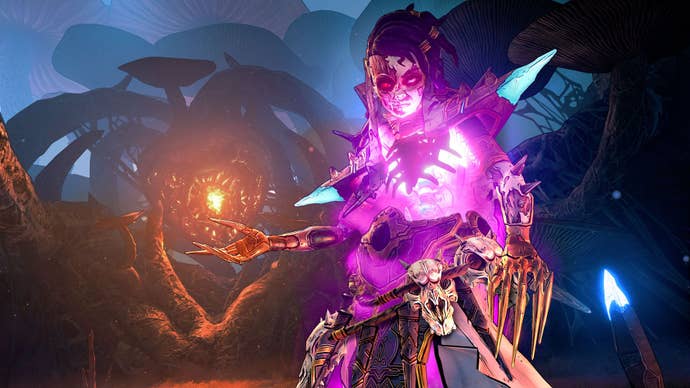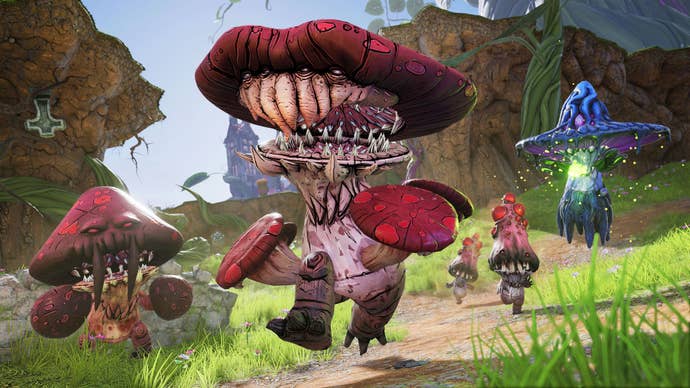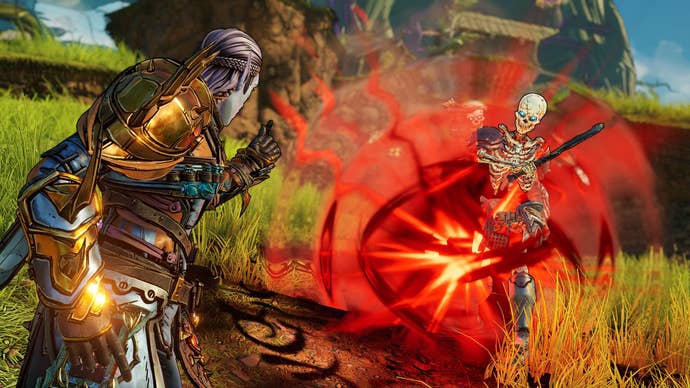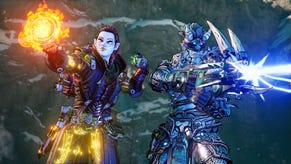Tiny Tina’s Wonderlands: Best builds for damage, melee, and companions
Looking to create a hero that can blast their way through Tiny Tina’s Wonderlands? Here are a handful of ideas for you.
Tiny Tina’s Wonderlands takes the form of a TTRPG within an RPG, borrowing from Dungeons & Dragons, as well as its predecessors, the Borderlands series. The Wonderlands is packed with wacky weapons to collect and quirky quests to complete, but before all that, you need to choose the best build that's right for your playstyle.
The character customisation options on offer in Tiny Tina’s Wonderlands are arguably an improvement on prior games. Not only are there multiple unique classes to pick from, you later get to combine classes, and you can attribute stats to your character to craft a hero fit to take on the Dragon Lord.
You can respec your character at any point, so how you distribute your attributes initially isn’t so important; it’s merely something to think about (I'll delve into those a little more at the end of this guide). When it comes to choosing your secondary class, however, you will want to think about this a little more if you’re looking to put together a powerful build. We’ve suggested a handful of builds below as guidelines for you and your character in Tiny Tina’s Wonderlands!
- The Damage Build - Spellshot and Stabbomancer
- The Companion Build - Graveborn and Spore Warden
- The Melee Build - Clawbringer and Brr-Zerker
- Where to assign Hero Points

The Damage Build - Spellshot and Stabbomancer
The clue is in the name, and this build is ideal for those who want to deal as much damage as possible across the Wonderlands. Additionally, it’s speedy and primarily relies on gun play.
I’ll delve into what Passive Skills you should invest in, some tips for playing that build, and suggest what sort of weapons and gear you should be looking for in order to fully kit this character out.
Passive Skills - Where should you put your points in the Skill Tree?
The Passive Skills below are suggestions, and it’s up to you exactly how many points you put into each. For clarity, I’ve noted the maximum amount of points that can be applied.
I recommend trying to put as many points as possible into the below, but sometimes, you may have extra points to spare. You can put these extra points into the skills below, or maybe invest in another skill that you think will benefit your play style!
Spellshot- Magic Bullets (3 Points) - A portion of the buffs to your spell damage are also applied to your gun damage. As a Spellshot, you’re going to get a lot of stacks from Spellweaving, which means you can buff your gun damage by a significant amount.
- Prestidigitation (5 Points) - Reload speed is increased. Considering we’re going to be relying on our gun to deal the majority of the damage, it’s handy to have a faster reload speed to hand, so you can keep firing.
- Just Warming Up (5 Points) - As you cast spells and create Spellweaving stacks, this skill will increase your fire rate with each stack. Again, for a maximum damage build, this is going to prove pretty useful.
- High Thread Count (1 Point) - Using a single point, this increases how many Spellweaving stacks you can have. Given the prior skills, with stacks, your damage and fire rate will be increased!
- Imbued Weapon (5 Points) - Whenever you cast a spell, your gun will deal bonus damage (corresponding to the spells' element) for a short time. Again, when it comes to dealing maximum damage with your gun, this is a must.
- Haste (3 Points) - If we’re firing fast, we want to be able to move even faster too. This skill increases movement speed and melee attack speed, and whenever you cast a spell, the boost is doubled.
- Arsenal (5 Points) - This skill generally increases your overall spell, melee, and gun damage. You don’t need to whack all your points into this, but having a few in Arsenal is an extra buff.
- Swift Death (5 Points) - If you’re moving, you’ll deal an increase amount of damage for attacking while doing so. As someone who is swift and gains extra speed with spell-casting, plug some points into this and don’t forget to be on the move while firing.
- Exploit their Weakness (5 Points) - If you inflict a status effect upon an enemy, they’ll take additional damage from all sources for a short period of time. This synergises with Spellshot’s Imbued Weapon nicely, meaning you can regularly inflict status effects and therefore deal more damage.
What weapons and items should you use?
With a build that is set up to deal copious amounts of damage, you can pretty much choose whatever you’ve taken a liking to as your weapon. Provided it’s to your level, it’s going to do the job. The crossbow pistols are a personal favourite when it comes to dealing damage, however, and Ruby’s Spite of the Shrike, one of the Wonderlands’ many legendaries, works a treat.
As for your spells, it depends on what's in your inventory. When it comes to rings and amulets, choose spells of an element that align with whatever your accessories boost. For example, if you have an amulet that can boost your fire damage, choose fire spells. However, to get the most out of status effect stacks, I’d try and have these be of a different element to your weapon.
Next, you want to consider your armor. There’s a few to choose from, but you want to find something that compliments your Passive Skills. Ultimately, you want a piece of armor that can buff your damage further, or increase your movement speed.
To truly inflict devastation on your enemies, you ideally want the Desperate Cursed Wit as your Ward in this case. Whenever your Ward is depleted, you’ll have a slight decrease in incoming damage, but a 100% increase in your outgoing damage. You also regenerate your health slowly whenever it is under 50%. This is literally a game-changer for this build, turning all your damage-boosting skills into something even bigger.

The Companion Build - Graveborn and Spore Warden
The Companions of Tiny Tina’s Wonderlands may get in the way sometimes, but they’re surprisingly smart, strong, and they’re of great service to your character. Crafting a build that gets the most out of your Companions can make a battle a lot easier, and who doesn’t love some company in the form of a notorious little mushroom?
Passive Skills - Where should you put your points in the Skill Tree?
When it comes to the Companion Build and selecting your Passive Skills, there are a few necessities, but there’s a lot of freedom overall. You want to focus on skills that’ll boost your companion damage, but putting points into your spell and ability damage will also prove useful!
Graveborn- Faithful Thralls (3 Points) - For every Companion that you have, you will deal an increased amount of damage, and their respawn rate is increased significantly.
- Stain of the Soul (5 Points) - This skill causes your spells to deal bonus dark magic damage.
- Dark Hydra (3 Points) - This ability is a kill skill, which grants you the chance to summon a Dark Hydra Companion that deals dark magic ability damage to enemies.
- Blast Gasp (5 Points) - Whenever you deal spell damage, there’s a chance of you causing an elemental explosion that deals ability damage.
- Kindred Heart (5 Points) - This increases both the health and damage of your Companions.
- Bullseye (5 Points) - This skill increases your chances of a gun critical hit, and does the same for your Companions too, so you can ensure that your pets are super hard-hitting.
- Thrill of the Hunt (3 Points) - This skill pairs nicely with Bullseye, as critical hits will now increase the damage your Companion deals. These boosts can additionally stack with each critical hit, which can lead to your Companions dealing a lot of damage.
What weapons and items should you use?
With this build, there’s a focus on amplifying our Companion's abilities. Therefore, you want to have as many Companions as possible during a fight. While you get Companions with both the Graveborn and Spore Warden as a class, you can actually recruit a few more.
For example, take care to pick up any weapons that allow you to summon Companions. One of my weapons would allow me to throw it, and then it would summon a Hydra Companion on impact (with the weapon appearing back in my hands immediately after). There are also weapons that summon Pixie Companions, and you can actually summon multiple of these Companions at a time.
The same can also be applied to various spells too. Much like weapons, there are spells that can summon multiple Companions at a time, too. One of the best for this is the Umbral Devouring Hydra, which summons one Hydra Companion who will then spawn another if one of the enemies that they have damaged is killed. To maximise your Companions, and their damage dealt, this (or any other Companion spells you may find) are a must-have for this build.
As for accessories and Wards, it’s really up to you what you choose to equip, as the focus here is more on your companions than yourself. There is class-specific armor that can boost your Companion damage, and it’s pretty rife across the Wonderlands, so be sure to grab one of these. When it comes to rings, amulets and Wards, anything that boosts your spell or ability damage is going to provide both you and your Companions a neat buff in some scenarios.

The Melee Build - Clawbringer and Brr-Zerker
I said in my review that I rarely used my melee weapon during Tiny Tina’s Wonderlands, considering all the wild weapons that it has to offer, but I definitely made sure to have some fun with the new feature. There is absolutely an avenue for you to master the melee across the Wonderlands, and this build helps you to do exactly that. You also have a Wyvern Companion to keep you company!
While this is a build with a heavier emphasis on melee damage, this is a Borderlands spin-off after all, and Clawbringer is best played with a mixture of melee and ranged attacks. Combining the two, dealing gun damage at range before jumping in to finish the job off with melee, can take a hot minute to get used to. However, with there being less of an emphasis on gun play, picking off enemies in this way can feel pretty rewarding.
Passive Skills - Where should you put your points in the Skill Tree?
Much like the Companion build, there’s an amount of freedom with your Passive Skills here. For bonus points, I recommend putting these into anything that amplifies your melee damage and status damage.
Clawbringer- Oath of Thunder (5 Points) - Your melee damage and your Companion will inflict bonus lightning damage.
- Blasthamut’s Favor (1 Point) - This is a kill skill that will summon an orb if you or your Companion kill an enemy. If you kill them with gun damage, a fire orb is sent to deal damage. If you kill them with melee damage, a lightning orb is sent instead.
- Friend to Flame (5 Points) - Your Wyvern Companion can deal an increased amount of damage with each level. While we’re focusing on maximising how much melee damage we deal, the Wyven Companion can be riotous at range, so it’s important to give them a little TLC with our skill choices.
- Storm Smite (1 Point) - This skill amplifies your Action Skill by bringing down a shower of lightning or fire bolts on enemies too. With your status damage boosted (which I’ll delve into when discussing Hero Points shortly), this will pack a punch.
- Savagery (5 Points) - This increases how long the Brr-Zerker’s class feat, Enrage, lasts, and also increases your melee damage.
- The Old Ways (5 Points) - For a melee build, this skill will come in clutch. It increases the amount of damage you deal while reducing the amount of incoming damage if an enemy is close to you.
- Ancient Fury (5 Points) - This skill will increase your maximum HP, and will also increase your area damage, which in turn, is going to work out really well with high status damage.
- Iron Squall (5 Points) - This skill will increase your fire rate and melee attack speed, and whenever you’re Enraged, the effect that these have on you is doubled.
What weapons and items should you use?
When it comes to weapons, you’re going to do a lot of dipping in and out of using melee. So, you’ll obviously want to have a strong melee weapon to hand, but you’ll want a weapon to suit this style of play too. Considering you’ll keep your enemies at a relatively close range, using an SMG or a reliable shotgun can be best for dealing enough damage to then run in with your melee.
As for your gear, be it your armor or accessories, you want to find items that will primarily buff your melee damage. A lot of this build relies more on tactically being able to weave in and out of fights, but don’t forget that you can also do a ground slam by jumping while crouching. This will cause a large AoE attack that can get enemies out of your way if you find you’re being overwhelmed by a horde of skeletons or crabs.
Where to assign Hero Points
I haven’t touched upon Hero Points much in these builds, as depending on what your Passive Skills are amplifying, it becomes pretty obvious what attributes you want to boost.
With the melee build, you want to put most of your Hero Points into Wisdom (to boost status damage) and Constitution (increase max HP/Ward). For the Companion build, put these points into Intelligence instead to reduce your spell cooldown time.
For every build, you may want to consider putting some points into Strength to make sure you’re getting something out of your critical hits. Strength is especially important for the damage build, teamed with Dexterity to increase your chances of a critical hit.
Beyond that, Hero Points aren’t the be all and end all, and most of the uniqueness of your build comes from Passive Skills and abilities unique to each class!
For more on Tiny Tina’s Wonderlands, we recommend increasing your Loot Luck to get yourself more legendary items, or try finding all the Shrine Pieces for more buffs.







.jpg?width=291&height=164&fit=crop&quality=80&format=jpg&auto=webp)


